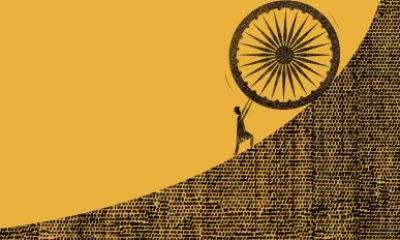
|
Getting your Trinity Audio player ready...
|
(The article was originally published in Indian Express on November 22, 2025 as a part of Dr Madhav’s column titled ‘Ram Rajya’. Views expressed are personal)
Prime minister Narendra Modi and RSS chief Mohan Bhagwat will be in Ayodhya next week for the Dhwajaarohan ceremony – hoisting of the sacred flag – in the precincts of the newly built Ram temple. Coming together second time in less than two years, the two leaders of the Ram Janmabhoomi movement would be proclaiming the conclusion of Mission Ram Temple, a five-century long campaign that saw royal wars, street fights and court battles for several generations. Finally, as the flag rises high next Tuesday, it will symbolise victorious culmination of the saga of faith, self-respect and sacrifice.
Flags in Hindu temples typically signify not only the victory and accomplishment, but also a spiritual connect and a value system. The flag being hoisted in Ayodhya too will carry symbols of Ram’s lineage, that represent an enduring link between the human and the divine on the one hand, and a glorious value system, which the medieval poet Tulsi Das aptly described as “Raghukul Reeti” – the culture of Raghu lineage to which Bhagwan Ram belonged.
For centuries during the struggle for Ram Temple, the mission of the people was to liberate the birthplace of Bhagwan Ram and build a magnificent temple that marked the obliteration of symbols of slavery. Now that the mission was accomplished successfully, what next? For some, the answer could be to look for other grievances and demand remedies. But for many others, the road ahead after the culmination of Mission Ram Temple would be to set the ball rolling for Mission Ram Rajya. After all, many leaders, including Lal Krishna Advani, who undertook the historic Rath Yatra, publicly asserted many times that the end objective of the movement was to build Ram Rajya.
On a visit to Ayodhya as part of his Bharat Uday Yatra, Advani, as the Deputy Prime Minister, said in April 2004 that Ram was not merely a religious figure but an epitome of a perfect ruler. “I have often used Ram Rajya to describe our goal of making India a developed economy and a world power by 2020”, he said, adding that the Ram Temple in Ayodhya will be a “vibrant symbol of a strong, prosperous and harmonious India”. As India continues to embark on that path of progress and prosperity, it is important to renew that commitment to building the Ram Rajya.
Unlike the 4th century theologian Saint Augustin of Hippo who exhorted early Christians of the Roman empire that “unless you believe, you will not understand”, Hinduism insisted that men should be “seekers”, not merely “believers”. “Hinduism is a movement, not a position; a process, not a result; a growing tradition, not a fixed revelation”, wrote eminent scholar – politician Dr Sarvapalli Radhakrishnan in his seminal work The Hindu View of Life. Ram Rajya represents that seeking of a life of values that Ram personified, not merely worshipping him. Ram was a god for many. Gandhi called him his personal deity. Ram’s historicity or otherwise never bothered Gandhi. What mattered was the concept of “Ram Rajya”, which essentially meant equal rights to “prince and pauper”.
During his two visits to Ayodhya, in 1921 and 1929, Gandhi’s rhetoric was about standing up for the weak and the meek. “Praying to God for our own protection is a sin as long as we do not protect the weak”, he told the saints of Ayodhya during his visit in February 1921, citing the example of how Ram protected Sita. There is no way to achieve Ram Rajya or Swaraj without observing this Svadharma, he told them.
Babasaheb Ambedkar had a different view. He was critical of Ram’s treatment of Sita. Commenting on Ram’s dismissal of Sita to forests the second time, he quipped that “there are not wanting Hindus who use this as grounds to prove that Ram was a democratic king when others could equally well say that he was a weak and cowardly monarch.” Both Gandhi and Ambedkar were looking at the concept of Ram Rajya from their respective prisms. But both insisted on a just system where the weak are protected and human dignity is upheld.
Delivering Ramnath Goenka Memorial Address recently, prime minister Modi alluded to the same stating that not “election”, but “emotion” should drive political leadership. He emphasised that when there is an inner restlessness to waste not a single minute to ameliorate the hardships of the poor, then continuous hard work becomes the driving force. The prime minister attributed Bihar election results to “governance carried out with this emotion and commitment”.
Ram also represented a glorious personal ideal, which Valmiki described as “Maryada Purushottam” – “ideal manifestation of dignity and decency”. “Did you kill Ravan?”, Mother Kausalya asks him after his return to Ayodhya. Ram’s reply was: “Mahagyani, Mahapratapi, Mahabalashali, Akhand Pandit, Mahan Shivbhakt, author of Shiv Tandav Stotra, the mighty Lankesh was killed by his own ego”. Ram epitomised great moral virtue – as not only an ideal king, but also an ideal son, husband, brother, friend and even an ideal enemy. Dignity of humans, irrespective of their position and pelf, was an article of faith with him.
In the vitiated climate of public discourse today, we, on the one hand, glorify Ram for offering dignity to the views of a washerman in his kingdom, yet, at the same time, we don’t hesitate to troll a brilliant woman cricketer for her religious beliefs. It is time that the country turns to that personal ideal of Maryada of Ram, besides the ideal of Ram Rajya, which Gandhi summed up as “the sovereignty of the people based on pure moral authority”.




